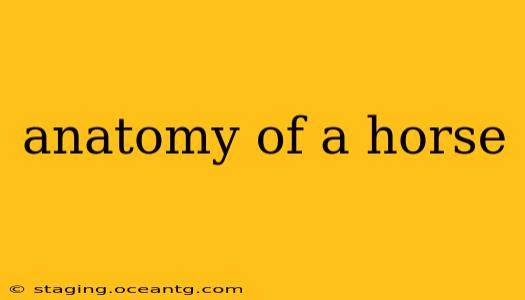The anatomy of a horse is a fascinating subject, encompassing a complex system of bones, muscles, organs, and other structures that allow for its incredible athleticism and grace. Understanding equine anatomy is crucial for horse owners, riders, veterinarians, and anyone interested in these magnificent animals. This guide delves into the key components, addressing common questions and providing a comprehensive overview.
What are the main external features of a horse?
A horse's external anatomy is easily observable and provides valuable clues to its health and conformation. Key features include:
- Head: The horse's head comprises the skull, containing the brain, and facial features like the eyes, ears, nostrils (important for respiration), and mouth (housing the teeth crucial for grazing). The shape and size of the head can vary between breeds.
- Neck: The neck connects the head to the body, providing flexibility and range of motion. Muscles in the neck are essential for carrying the head and supporting its weight.
- Shoulder: The shoulder is a critical area impacting movement and gait. It is a complex joint where the forelimb connects to the body.
- Chest: The chest houses the heart and lungs, vital organs for respiration and circulation. Depth and width of the chest are crucial for athletic performance.
- Back: The horse's back is relatively short, and its strength is essential for carrying weight. A strong back is important for both riding and work.
- Loin: The loin is the area between the ribs and hips, providing connection and support between the fore and hindquarters.
- Hips (Croup): The hips form the hindquarters, influencing the horse's power and balance. The slope of the croup impacts movement.
- Tail: The tail serves as a fly swatter and is a crucial part of the horse's balance.
- Legs: The horse's legs are long and slender, with specialized joints and bones adapted for speed and agility. The arrangement of tendons and ligaments is crucial for support and movement. Noticeable features include the knees (carpal joints) and hocks (tarsal joints). The hooves are essential for locomotion, providing protection and shock absorption.
What are the main internal organs of a horse?
A horse's internal anatomy is equally complex, supporting its life functions. Key internal systems include:
- Digestive System: Horses are hindgut fermenters, meaning digestion occurs mainly in the cecum and large intestine. This system is adapted for processing large quantities of fibrous plant material.
- Respiratory System: The respiratory system consists of the lungs and associated airways, enabling oxygen intake and carbon dioxide expulsion. The large lung capacity supports strenuous activity.
- Circulatory System: The circulatory system, composed of the heart, blood vessels, and blood, transports oxygen, nutrients, and other essential substances throughout the body.
- Nervous System: The nervous system, including the brain and spinal cord, controls movement, sensation, and all other bodily functions.
- Musculoskeletal System: This system, made up of bones, muscles, tendons, and ligaments, enables movement, support, and posture. Horses possess a remarkably strong musculoskeletal system.
How does a horse's skeletal system work?
The equine skeleton is adapted for locomotion, weight-bearing, and speed. It consists of over 200 bones, including:
- Axial Skeleton: Comprising the skull, vertebral column (including neck, back, loin, and tail bones), and ribs.
- Appendicular Skeleton: This includes the bones of the forelimbs (scapula, humerus, radius, ulna, carpal bones, metacarpal bones, and phalanges) and hindlimbs (pelvis, femur, tibia, fibula, tarsal bones, metatarsal bones, and phalanges).
The skeletal structure supports the body, protects vital organs, and provides attachment points for muscles.
What are the major muscle groups in a horse?
Horses possess highly developed muscles crucial for their athleticism. Major muscle groups include:
- Neck Muscles: Support the head and enable movement.
- Shoulder Muscles: Power the forelimbs during locomotion.
- Back Muscles: Support the weight of the rider and the body.
- Hip and Thigh Muscles: Provide powerful propulsion for movement.
- Leg Muscles: Control precise movement and provide stability.
The intricate interaction of these muscle groups allows for a remarkable range of motion and athletic performance.
What are some common health problems related to a horse's anatomy?
Understanding equine anatomy is crucial for identifying and addressing potential health issues. Common problems related to anatomical structures include:
- Laminitis: Inflammation of the sensitive laminae within the hoof.
- Colic: Abdominal pain stemming from various digestive issues.
- Navicular Syndrome: Pain affecting the navicular bone in the hoof.
- Osteoarthritis: Degenerative joint disease affecting various joints.
- Muscle Strain or Tear: Injuries affecting the muscles and tendons of the limbs and back.
This comprehensive overview provides a foundation for understanding the remarkable anatomy of the horse. Further research into specific areas of interest will enhance knowledge and appreciation of these magnificent creatures. Remember to consult with equine veterinary professionals for any health concerns related to your horse.
